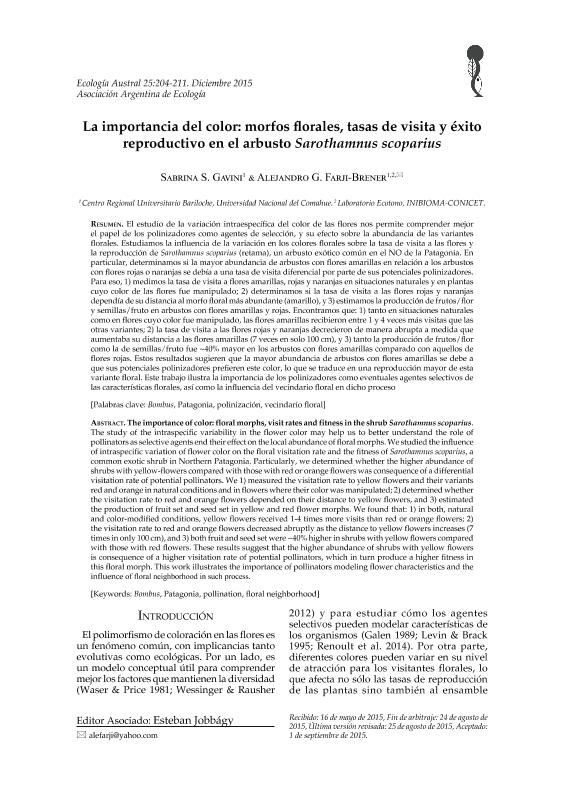Artículo
El estudio de la variación intraespecífica del color de las flores nos permite comprender mejor el papel de los polinizadores como agentes de selección, y su efecto sobre la abundancia de las variantes florales. Estudiamos la influencia de la variación en los colores florales sobre la tasa de visita a las flores y la reproducción de Sarothamnus scoparius (retama), un arbusto exótico común en el NO de la Patagonia. En particular, determinamos si la mayor abundancia de arbustos con flores amarillas en relación a los arbustos con flores rojas o naranjas se debía a una tasa de visita diferencial por parte de sus potenciales polinizadores. Para eso, 1) medimos la tasa de visita a flores amarillas, rojas y naranjas en situaciones naturales y en plantas cuyo color de las flores fue manipulado; 2) determinamos si la tasa de visita a las flores rojas y naranjas dependía de su distancia al morfo floral más abundante (amarillo), y 3) estimamos la producción de frutos/flor y semillas/fruto en arbustos con flores amarillas y rojas. Encontramos que: 1) tanto en situaciones naturales como en flores cuyo color fue manipulado, las flores amarillas recibieron entre 1 y 4 veces más visitas que las otras variantes; 2) la tasa de visita a las flores rojas y naranjas decrecieron de manera abrupta a medida que aumentaba su distancia a las flores amarillas (7 veces en solo 100 cm), y 3) tanto la producción de frutos/flor como la de semillas/fruto fue ~40% mayor en los arbustos con flores amarillas comparado con aquellos de flores rojas. Estos resultados sugieren que la mayor abundancia de arbustos con flores amarillas se debe a que sus potenciales polinizadores prefieren este color, lo que se traduce en una reproducción mayor de esta variante floral. Este trabajo ilustra la importancia de los polinizadores como eventuales agentes selectivos de las características florales, así como la influencia del vecindario floral en dicho proceso. The study of the intraspecific variability in the flower color may help us to better understand the role of pollinators as selective agents end their effect on the local abundance of floral morphs. We studied the influence of intraspecific variation of flower color on the floral visitation rate and the fitness of Sarothamnus scoparius, a common exotic shrub in Northern Patagonia. Particularly, we determined whether the higher abundance of shrubs with yellow-flowers compared with those with red or orange flowers was consequence of a differential visitation rate of potential pollinators. We 1) measured the visitation rate to yellow flowers and their variants red and orange in natural conditions and in flowers where their color was manipulated; 2) determined whether the visitation rate to red and orange flowers depended on their distance to yellow flowers, and 3) estimated the production of fruit set and seed set in yellow and red flower morphs. We found that: 1) in both, natural and color-modified conditions, yellow flowers received 1-4 times more visits than red or orange flowers; 2) the visitation rate to red and orange flowers decreased abruptly as the distance to yellow flowers increases (7 times in only 100 cm), and 3) both fruit and seed set were ~40% higher in shrubs with yellow flowers compared with those with red flowers. These results suggest that the higher abundance of shrubs with yellow flowers is consequence of a higher visitation rate of potential pollinators, which in turn produce a higher fitness in this floral morph. This work illustrates the importance of pollinators modeling flower characteristics and the influence of floral neighborhood in such process.
La importancia del color: Morfos florales, tasas de visita y éxito reproductivo en el arbusto Sarothamnus scoparius
Fecha de publicación:
12/2015
Editorial:
Asociación Argentina de Ecología
Revista:
Ecología Austral
ISSN:
1667-7838
Idioma:
Español
Tipo de recurso:
Artículo publicado
Clasificación temática:
Resumen
Palabras clave:
Bombus
,
Patagonia
,
Polinizacion
,
Vecindario floral
Archivos asociados
Licencia
Identificadores
Colecciones
Articulos(INIBIOMA)
Articulos de INST. DE INVEST.EN BIODIVERSIDAD Y MEDIOAMBIENTE
Articulos de INST. DE INVEST.EN BIODIVERSIDAD Y MEDIOAMBIENTE
Citación
Gavini, Sabrina; Farji Brener, Alejandro Gustavo; La importancia del color: Morfos florales, tasas de visita y éxito reproductivo en el arbusto Sarothamnus scoparius; Asociación Argentina de Ecología; Ecología Austral; 25; 3; 12-2015; 204-211
Compartir




